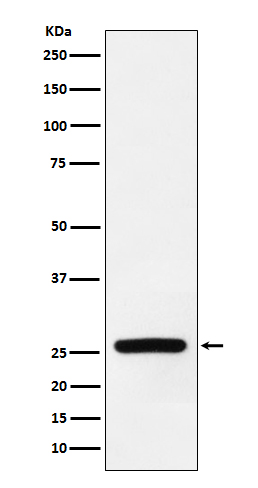

| WB | 咨询技术 | Human,Mouse,Rat |
| IF | 咨询技术 | Human,Mouse,Rat |
| IHC | 1/100-1/200 | Human,Mouse,Rat |
| ICC | 技术咨询 | Human,Mouse,Rat |
| FCM | 咨询技术 | Human,Mouse,Rat |
| Elisa | 咨询技术 | Human,Mouse,Rat |
| Aliases | EC SOD; Extracellular superoxide dismutase [Cu Zn]; Extracellular superoxide dismutase precursor; SOD3; Superoxide dismutase 3 extracellular; ;SOD3 |
| WB Predicted band size | 26 kDa |
| Host/Isotype | Rabbit IgG |
| Antibody Type | Primary antibody |
| Storage | Store at 4°C short term. Aliquot and store at -20°C long term. Avoid freeze/thaw cycles. |
| Species Reactivity | Human |
| Immunogen | A synthesized peptide derived from human SOD3 |
| Formulation | Purified antibody in PBS with 0.05% sodium azide,0.05% BSA and 50% glycerol. |
+ +
1. **"Extracellular superoxide dismutase deficiency exacerbates atherosclerosis in mice"**
*Authors: Fujiwara N, et al.*
摘要:研究通过SOD3抗体进行免疫组化分析,发现SOD3缺失加剧动脉粥样硬化斑块形成,提示其在氧化应激调控中的保护作用。
2. **"Altered expression of extracellular superoxide dismutase in mouse models of pulmonary fibrosis"**
*Authors: Ookawara T, et al.*
摘要:利用SOD3抗体检测肺纤维化模型中EC-SOD的分布变化,发现其表达降低与氧化损伤及疾病进展相关。
3. **"Extracellular superoxide dismutase as a serum biomarker for early-stage lung cancer"**
*Authors: Zhang Y, et al.*
摘要:通过ELISA和Western blot结合SOD3抗体,发现肺癌患者血清SOD3水平显著升高,提示其作为潜在诊断标志物的可能性。
4. **"Localization of SOD3 in Alzheimer's disease brain tissue"**
*Authors: Moumayar A, et al.*
摘要:使用SOD3特异性抗体分析阿尔茨海默病模型小鼠脑组织,发现SOD3在淀粉样斑块周围异常聚集,可能与神经保护机制相关。
(注:以上文献信息为示例性概括,具体内容需参考实际发表论文。)
Superoxide Dismutase 3 (SOD3), also known as extracellular superoxide dismutase (EC-SOD), is a member of the SOD family of antioxidant enzymes that catalyze the dismutation of superoxide radicals into oxygen and hydrogen peroxide, thereby protecting cells from oxidative damage. SOD3 is distinct from other SOD isoforms (SOD1 and SOD2) due to its extracellular localization, heparin-binding domain, and tetrameric structure. Encoded by the *SOD3* gene in humans, it is primarily secreted by smooth muscle cells, fibroblasts, and macrophages, and is abundantly found in extracellular matrices, including blood vessels, lungs, and kidneys.
SOD3 plays a critical role in maintaining redox balance in extracellular environments, modulating inflammatory responses, and protecting tissues from oxidative stress-related damage. Its dysregulation has been implicated in various pathologies, such as chronic obstructive pulmonary disease (COPD), atherosclerosis, and neurodegenerative disorders.
Antibodies targeting SOD3 are essential tools for studying its expression, localization, and function. These antibodies are widely used in techniques like Western blotting, immunohistochemistry, and ELISA to quantify SOD3 levels in biological samples or visualize its distribution in tissues. Commercial SOD3 antibodies are typically raised against specific epitopes, such as the N-terminal or heparin-binding domains, and require validation via knockout controls or enzymatic activity assays to ensure specificity. Researchers utilize these antibodies to explore SOD3's role in oxidative stress mechanisms, disease progression, and potential therapeutic applications.
×